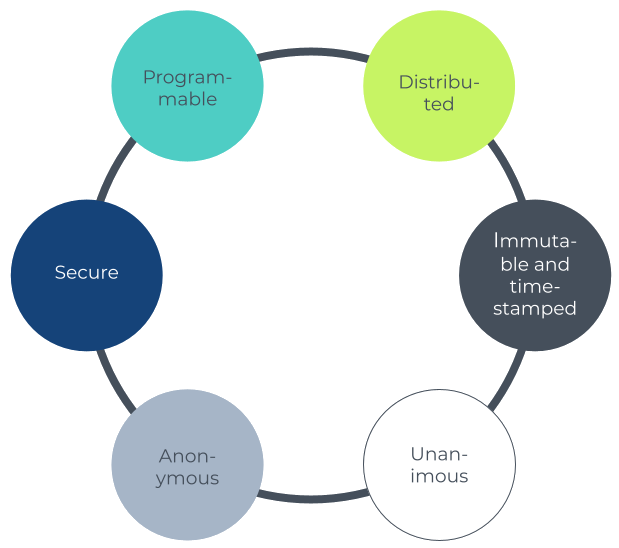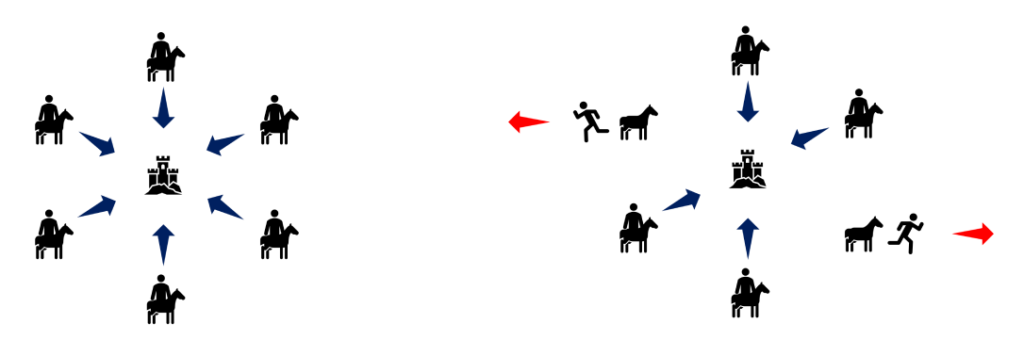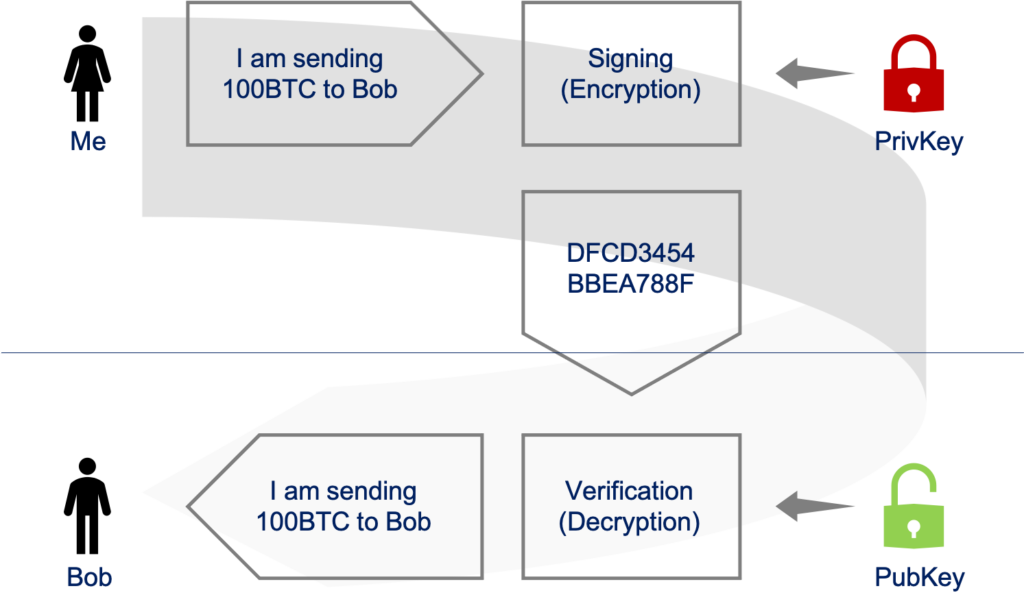Blockchain Definition
Blockchain is a software technology that allows the sharing of information peer to peer.
Key Points
- Blockchains, like their name indicates, store data in “blocks” which are chained together.
- Every transaction is saved into a new block.
- A new block is then chained to the previous block of data.
- The data is chained in chronological order and sealed with a time stamp.
- The information stored in the blockchain can be shared without the need of third-party intermediaries, such as banks, government organisations, etc.
- The goal of blockchain is to allow digital information to be recorded and distributed only. Editing is not possible and nothing can be undone.
- The three main characteristics of a blockchain are: Immutability, decentralisation and safety.
Immutability
- Transactions are permanently recorded, immutable, and cannot be changed by anyone.
- The data stored in each block is visible to everybody, yet not changeable.
- When a new block is stored, it transforms into “stone” and becomes part of the blockchain timeline.
- Each new block is given a timestamp with the exact date and time it was recorded.
- No single person or group of people have control, rather all together, collectively.
Decentralisation
- Each computer or group of computers is in a different geographic location and are operated by separate individuals or groups of people.
- These computers that makeup the network are called nodes.
- This method aids in the establishment of a precise and straightforward sequence of events.
Safety
- Each new block stored in the block chain is saved chronologically and linearly.
- Each block has its own hash, as well as the hash of the previous block and the time stamp.
- A math function converts digital data into a string of numbers and letters, resulting in hash codes.
BLOCK = HASH (previous block)+ Timestamp
Advantages
Accuracy of the Chain
Cost Reductions
Decentralisation
Efficient Transactions
Private Transactions
Secure Transactions
Transparency
Banking the Unbanked
Disadvantages
Technology Cost
Speed Inefficiency
Illegal Activity
Regulation
Ledger
A ledger records activity, ownership and transfer of value between stakeholders.
Public Ledger
- A public ledger is a record-keeping system.
- The ledger maintains participants’ identities anonymously (pseudonymously)
- It records all the transactions executed between network participants.
- Scaling and security concerns are one of the challenges for public ledgers.
- Similar to the bank records, the transaction details on a public ledger can be verified and queried by the two transacting participants. Their identities remain unknown.


Centralised vs Distributed (Decentralised) Ledgers

Centralised Ledger (Owned/ Controlled)
- The general ledger is the backbone of any accounting system which holds financial and non-financial data.
- Example: A general ledger contains all the accounts for recording transactions relating to a company’s assets, liabilities, owners’ equity, revenue, and expenses.

Distributed (not owned)
- A database that lives across a network of multiple sites, geographies or institutions.
- Each participant may each have their own identical copy of the ledger.


Ledgers and Ownership
- Nodes are devices in charge of handling transactions and keeping track of all records, including those of ownership.
- Anyone can become a node by downloading the free open-source Bitcoin programme.
- No single node prevails over the others. None is trusted, and all nodes are treated equally.
What problem does blockchain solve?
Byzantine Generals Problem in Blockchain Technology
- The main challenge that distributed networks are faced with is consensus.
- In the event of a faulty or defective component, the network needs to manage the failure and prevent any damage.
- A failed processed could be triggered by a component that crashes, re-boots or shuts down, or even behaves byzantine.
- This problem is best known as “problem of the Byzantine Generals”.
- In the case of Bitcoin, the entire network of nodes needs to agree on the validity of transactions.
- There is always a risk of misinformation or miscommunication between users, whether accidental or deliberate, which is why consensus is key.
- Distributed Ledger Technology, and several other types of computer networks, would fail to function properly.
- The loyalty of more than 50% of the nodes that constitute the blockchain network is key to reach consensus and, thus, provide a solution to the problem.

Blockchain Cryptography
Hash
A hash is a function that transforms a string of letters and numbers into a fixed-length encrypted output.
What is a Blockchain Hash?
- A cryptographic hash function is a mathematical process that transforms identical data into a unique, fixed-size code, which is widely used to verify data authenticity.
- Any data alteration, whether accidental or malicious, would fully alter the hash code.
Cryptographic Hash Functions
- Password storage is the most coord storage is the most common use for a Hash
- Hash functions are one of the ground pillars of the blockchain technology and ensure immutability.
- Solving the hash starts with the data available in the block header.
- Each block header contains:
- Version number
- Timestamp
- Hash of previous block
- Hash of the Merkle Root
- Nonce
- Target Hash
- Fun Fact: Satoshi wanted to avoid confusion in Bitcoin addresses, so he removed O0lI characters.
Bitcoin Hash Key
Private Key (PrivKey)
- It is initially generated at random, and is kept secret at all times.
- It is used to transfer bitcoins from one owner to the other. The original owner has to digitally sign off the transaction to validate it.
- The digital signature of a transaction confirms ownership and can be used to check that the transaction is genuine.
Public Key (PubKey)
- The public key is generated from the private key using a unique has function.
- It is used by the new owner to verify the digital signature of a transaction.

What are some uses of blockchain?
- Currency
- Digitalised Commodities
- Record keeping
- Process monitoring
- Quality Assurance
Companies Currently Using Blockchain Technology
| Bank and Finance | HSBC | BBVA | Barclays | VISA | Intesa Sanpaolo |
| Supply Chain | AB InBev | Walmart | DB | Ford | Unilever |
| Healthcare | Pfizer | Change Healthcare | FDA | CDC | DHL |
| Insurance | AEGON | Prudential | MetLife | AIA | AIG |
| Energy | SIEMENS | Shell | Adnoc | CNE | Tennet |
| Real Estate | Westfield | JLL | Brookfield | Coldwell Banker | LINK |
| Trade | ANZ | Bank of China | SEB | Scotiabank | MIZUHO |
| Government | Government of Dubai | MAS | Seoul | Lantmäteriet | Uganda National Drug Authority |
| IoT | Smart Electric Power Alliance | McKesson | Van Dorp | Commonwealth Bank | Maersk |
| Travel | ETIHAD Airways | Singapore Airlines | DELTA | British Airways | Lufthansa |
Uses for Blockchain outside Crypto
Blockchain (in conjunction with “smart contracts”) has many other applications outside the crypto world. It can help address more complex issues. For example:
- Public Records:
-
- Land titles, Criminal records, Voter records, Court records
- Private Records:
- Wills, Trusts
- Other uses:
- Certifications, Medical records, etc.
Music/ Art Registration
- Ownership is registered permanently therefore no need for record labels to have a share of the artist’s work.
- Smart Contracts technology allows artists to set automated payments to them based on licenses they design themselves.
Academic Certificates
- Ease of Publication & Distribution
- Independent validation
- Immutable Records
- Reduced time and cost to issue (and re-issue) certificates
- Data is accessible, even if the university or the institution’s website is no longer accessible.
- Employers can verify job applications instantly, ensuring that a candidate is presenting valid academic certifications.
Real Estate Management
- Property owners could digitally prove and transfer ownership immediately without the need to pay and wait for third-party verification.
- A “digital ownership certificate” cannot be replicated, making selling or advertising properties you don’t own almost impossible, reducing property fraud.
- Faster mortgage process and transfer of ownership.
- Credit history, income could be checked immediately, saving time spent dealing with banks, attorneys, and intermediaries.
- Homeowners may show that they own the property and have lived there for a certain amount of time.
- Digital IDs may be attributed to properties, which would include the chain of ownership, a list of repairs, and other relevant information.
Supply Chain Shipping
- Allows digitisation of the supply chain process
- Reduce the time spent in transit and during the shipment process, by tracking the paper trails of shipping containers.
- Enhance product accountability and protection while lowering costs and complexity
- Reduce fraud and defects in product quality by improving stock control.
Solar Energy Management
- Energy buying and selling is decentralised and direct among participants, ensuring independence from a third-party power supplier.
- Transaction data is stored, as well as the amount of electricity produced per participant in a network.
- A community or an area may set up a solar-powered energy trading system and keep track of transactions between residents.
- Instead of selling excess energy back to the power provider, users can exchange it among themselves.
- Participants can sell their excess energy to whom they decide and decide its price.
NFTs – Non- Fungible Tokens
A non-fungible token (NFT) is a digital file stored on a blockchain that certifies its uniqueness.
What are NFTs?
- NFTs are non-fungible digital tokens that run, mostly, on the Ethereum blockchain using smart contracts.
- CryptoKitty is the first NFT, with each kitty being an ERC-721 token.
- They can be used to share digital assets and use the blockchain to check their validity.
- While anyone can access copies of these digital products, NFTs are monitored on blockchains to provide the owner with a proof of ownership that is distinct from copyright.
But why buy NFTs?
- Artwork NFTs are comparable to autographed art pieces.
- Non-fungible basically means that it’s one-of-a-kind and can’t be replaced by anything else.
- A bitcoin, for example, is fungible, meaning you can exchange one for another and get exactly the same thing.
- A digital file, including the art that comes with an NFT, can be replicated as many times as you want.
- NFTs are built to give you something that can’t be copied: ownership of the work.
- To put it another way, anybody can buy a Picasso print, however, the original can only be owned by one person.

Gucci Ghost sold for $3,600, but the current owner is asking for $16,300






